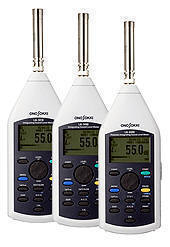What is sound level meter?
(3rd edition)
For those new to sound level meters
Laws and regulations on noise have changed drastically over the last ten years or so. During the period, the Basic Environment Act (April 1999), the Environmental Impact Assessment Act (June 1999) and the Noise Regulation Act (April 2000) have been revised or enacted. In a series of reviews, standards have also changed substantially such as JIS Z 8731 (ISO 1996-1:2003, ISO 1996-2:2007), which in 1999 recommended equivalent continuous A-weighted sound pressure level (LAeq). These revisions and reviews stemmed from the need to not only ensure a comfortable living environment but also ensure consistency between noise ratings used in environmental preservation efforts that have become increasingly global as well as in global commercial transactions of products, etc. and international standards.
In Japan, with an increasing number of organizations and businesses adopting environmental impact assessment systems conforming to ISO 14000, environmental preservation efforts have been growing. With this increasing awareness of environmental preservation, there has been increasing demand to not only measure noise and take actions but also predict noise and take action to reduce it in the stages of planning roads and other structures and designing automobiles, home electric appliances and other products.

Over the years, the sound level meters covered in this guide have become popular as easy-to-use sound measuring devices while increasingly gaining importance as an environment measuring instrument. The first edition of this guide "What is a sound level meter?" was issued in 1997. With the changing requirements described above, the first edition was subsequently determined no longer relevant to the times. In 2000, following a thorough review of the first edition, the second edition was issued. This third edition was issued in August 2009 following the revision of JIS sound standards for conformity to IEC standards that primarily concern sound level meters and octave-band filters. In this third edition, the technical content and division of chapters have been reorganized.
We hope you will find this guide useful as you start to use your sound level meter.
August 2009
January 1997: 1st edition issued
May 1997: 1st edition revised
September 2000: 2nd edition issued
December 2007: 2nd edition revised
August 2009: 3rd edition issued
December 2010: 3rd edition revised
August 2012: 3rd edition revised
April 2013: 3rd edition revis
MENU
4. Unit of noise measurement – Why the logarithmic scale "dB" is used
7. Overview of sound level meters
7-1 What is a sound level meter?
7-2 Differences between sound level meters (Class 2) and precision sound level meters (Class 1)
7-4 Measurement ranges of sound level meters (Linearity ranges)
7-5-1 Why is a wind screen necessary?
8. Structure of Sound level meter
8-2 Microphone and preamplifier
8-3 Frequency weighting Z- (or FLAT-), A- and C- weighting
8-4 Fast and slow time weighting
9-2 A-weighted sound pressure level (LA)
9-3 Equivalent continuous A-weighted sound pressure level (LAeq, T)
9-4 Sound exposure level (LAE)
9-5 Maximum noise level (Lmax) and minimum noise level (Lmin)
11. Octave band analysis (Frequency analysis)
11-2 JIS standards on octave filters
11-3 Octave filter bandwidth and center frequency
11-4 Calculation of overall level (aggregate band levels)
11-7 Loudness analysis (Loudness, Loudness level, Sharpness)
12. Calculation of deci Bel (dB)
12-1 Sum of dB values (Total power)
12-2 Average of dB values (Average power)
12-3 Difference of dB values (Power differential)
12-5 Method of calculating equivalent continuous A-weighted sound pressure level
12-6 Method of measuring percentile sound pressure level (50 measurements)
Japanese Industrial Standards (JIS)

